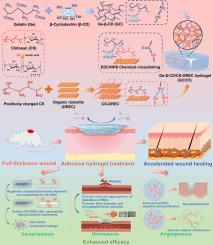Antibacterial chitosan/organic rectorite nanocomposite-conjugated gelatin/β-cyclodextrin hydrogels with improved hemostasis performance for wound repair
IF 10.7
1区 化学
Q1 CHEMISTRY, APPLIED
引用次数: 0
Abstract
Bacterial infections and severe bleeding continue to pose significant challenges in wound repair. There is an urgent need for innovative, nature-inspired hydrogel dressings with antibacterial and hemostatic properties. A Ge-β-CD-CS-OREC conjugate hydrogel was developed by grafting β-CD and CS-OREC nanocomposites into a Ge matrix using EDC/NHS crosslinking, as confirmed by FT-IR and EDX analyses. Compared to single Ge-β-CD cross-linked hydrogels, the addition of CS-OREC enhanced the hydrogel's properties, including increased pore size (60 ± 14 μm), improved wettability (WCA = 28.82 ± 0.6°), enhanced tensile strength (41.3 ± 3.56 KPa), and strong tissue adhesion. Furthermore, this hydrogel demonstrated excellent cytocompatibility when co-cultured with keratinocytes (Kcs) and vascular endothelial cells (VECs). The incorporation of CS chains into OREC interlayers allowed the hydrogel to specifically target bacteria and increase membrane permeability in Pseudomonas aeruginosa (PA), Klebsiella pneumoniae (KP), and Staphylococcus aureus (SA), effectively reducing the bacterial load in infected wounds by 50.24–73.92 % compared to controls in vivo. Further, the hydrogel exhibited superior hemostatic efficiency (78 ± 10 s) over commercial gauze and other gels by enhancing platelet activation and coagulation factor secretion. The hydrogel accelerated tissue regeneration by promoting epithelial maturation and blood vessel regeneration, indicating its clinical potential as promising wound dressing.

具有更好止血性能的抗菌壳聚糖/有机雷克托石纳米复合-共轭明胶/β-环糊精水凝胶用于伤口修复
细菌感染和严重出血仍然是伤口修复的重大挑战。目前迫切需要具有抗菌和止血特性的创新型自然启发水凝胶敷料。通过使用 EDC/NHS 交联法将 β-CD 和 CS-OREC 纳米复合材料接枝到 Ge 基质中,开发出了 Ge-β-CD-CS-OREC 共轭水凝胶,并通过傅立叶变换红外光谱(FT-IR)和乙二胺四乙酸氧化物(EDX)分析证实了这一点。与单一的 Ge-β-CD 交联水凝胶相比,CS-OREC 的加入增强了水凝胶的性能,包括增加了孔径(60 ± 14 μm)、改善了润湿性(WCA = 28.82 ± 0.6°)、提高了拉伸强度(41.3 ± 3.56 KPa)和较强的组织粘附性。此外,这种水凝胶在与角质细胞(Kcs)和血管内皮细胞(VECs)共培养时表现出了良好的细胞相容性。在 OREC 夹层中加入 CS 链后,水凝胶就能特异性地靶向细菌,并增加铜绿假单胞菌(PA)、肺炎克雷伯氏菌(KP)和金黄色葡萄球菌(SA)的膜渗透性,与体内对照组相比,能有效减少感染伤口中的细菌量 50.24-73.92%。此外,与商用纱布和其他凝胶相比,水凝胶通过增强血小板活化和凝血因子分泌,表现出更高的止血效率(78 ± 10 秒)。水凝胶可促进上皮成熟和血管再生,从而加速组织再生,这表明它具有作为伤口敷料的临床潜力。
本文章由计算机程序翻译,如有差异,请以英文原文为准。
求助全文
约1分钟内获得全文
求助全文
来源期刊

Carbohydrate Polymers
化学-高分子科学
CiteScore
22.40
自引率
8.00%
发文量
1286
审稿时长
47 days
期刊介绍:
Carbohydrate Polymers stands as a prominent journal in the glycoscience field, dedicated to exploring and harnessing the potential of polysaccharides with applications spanning bioenergy, bioplastics, biomaterials, biorefining, chemistry, drug delivery, food, health, nanotechnology, packaging, paper, pharmaceuticals, medicine, oil recovery, textiles, tissue engineering, wood, and various aspects of glycoscience.
The journal emphasizes the central role of well-characterized carbohydrate polymers, highlighting their significance as the primary focus rather than a peripheral topic. Each paper must prominently feature at least one named carbohydrate polymer, evident in both citation and title, with a commitment to innovative research that advances scientific knowledge.
 求助内容:
求助内容: 应助结果提醒方式:
应助结果提醒方式:


